Safety practices for hunt seat riders will help them avoid injury and trouble for themselves and the horse. Safety should become second nature — not taken for granted. Riders should constantly be aware of potentially dangerous situations and avoid them when possible.
As in other styles of riding, certain dangers are more common in certain phases of horsemanship. The safe rider learns to watch for these dangers before they arise.
Use sound equipment
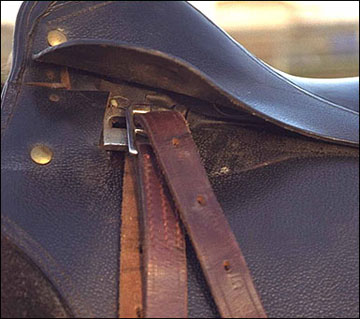
Using faulty equipment is a dangerous practice. Check all tack and equipment for soundness and good repair. Do not use worn out equipment. The condition of reins, girths and stirrup leathers is especially important.
Even in good condition, equipment can be dangerous if it does not fit the horse. Check adjustment of the bit, the browband, the noseband and the saddle as it sits on the horse's back. Poorly adjusted equipment rubs, chafes and irritates. It may even cause the horse to get out of control.
See that accessories such as martingales and breastplates are correctly adjusted and attached. Leave stirrup bars open to ensure that in an emergency, the leathers will pull free (Figure 1).
Mount safely
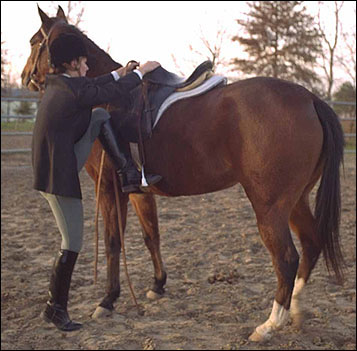
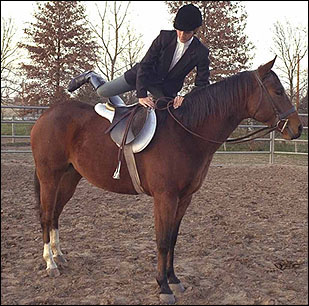
Before mounting your horse, make sure the girth is snug but not too tight. Tightening the girth as much as possible when the saddle is first put on annoys the horse. Lead the horse for.l short distance and tighten the girth again before mounting.
Before you mount, lead the horse away from objects that could injure either of you. Avoid mounting in stables with low ceilings, on slippery floors or in narrow doorways. Lead the horse away from trees, buildings and other horses.
Learn to mount smoothly and quickly without help. Beginning riders may prefer to have an assistant hold the horse while mounting. However, depending on an assistant beyond the learning stage is not advisable.
Some help in mounting is convenient for short riders or tall horses. A friend can help by "giving a leg up," or you may use a mounting block. It also is possible to lower the left stirrup a few notches, then readjust it after you are mounted.
Complete control of the horse is essential for safe mounting. The best method of mounting is for the rider to stand at the horse's shoulder facing to the rear. The left hand holds the reins and the right hand grasps the saddle (Figure 2). In this position, you maintain maximum control while retaining your balance.
Do not attempt to mount a horse that is not standing quietly. A great deal of training is required to teach a horse to stand. If the horse begins to move, pull up sharply on the reins with your left hand. If you are quick and smooth about mounting, the whole procedure will be much safer and the horse will be less likely to move.
As you gather the reins in your left hand, keep the left rein shorter than the right rein. If the horse moves, it will then circle around instead of moving away. Momentum will send your body into the horse and it will be easier to swing your leg over.
As you swing up to mount, brace yourself on your hands and straighten your left leg. Swing your right leg over the horse's back (Figure 3). Settle lightly into the saddle and pick up your right stirrup as quickly as possible. If the horse stands still, don't put pressure on the reins. It is important not to bump the horse's croup with your right leg while mounting or dismounting. This may startle your horse. It also will throw you off balance.
Kick free of stirrup in dismounting
Dismounting is the reverse of mounting and the same safety rules apply. Make sure your horse stands still for you to dismount. If it does not, check it with the reins.
An important safety procedure for hunt seat riders is to kick free of the stirrups before touching the ground. As you swing your right leg over the horse's back, stand up on your left leg. Lean over the horse, bracing yourself with your hands, and kick your left foot free of the stirrup. Then push yourself back and jump lightly to the ground. Do not let go of the reins!
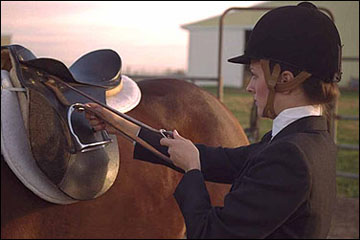
Stepping down from the saddle with the left foot in the stirrup as the right foot touches the ground is extremely dangerous for a hunt seat rider. A short-legged person mounted on a tall horse would be in an awkward position when stepping down. It is very easy for the foot to become caught in the stirrup and difficult to stop the moving horse.
As soon as you are dismounted, run the stirrups up unless you are planning to remount immediately (Figure 4). Dangling stirrup irons are dangerous. They can catch on objects such as latches, fences or gates and they annoy horses by bumping their sides. If your horse is scratching or biting at flies, it may catch its hind foot or lower jaw in the iron.
Check stirrup length when mounted
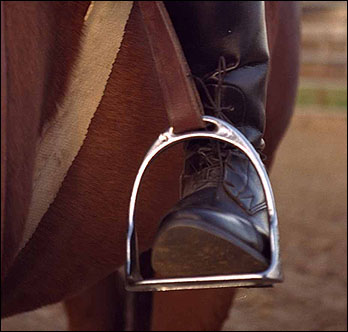
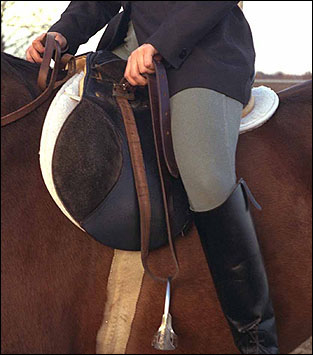
Once you are mounted, immediately check the length of your stirrup leathers. They should be adjusted to roughly the right length before you mount, but once mounted you should put them exactly where you want them. Hunt seat rider's stirrups should reach just below the ankle bones. There can be some variation up or down, depending on the type of riding, the style of saddle and the rider's physical build. A rider who anticipates taking fences may wish to have the irons higher.
Stirrup irons should fit your boots. The width of the tread of the stirrup should be 1/2 to 3/4 inches wider than the width of the boot at the ball of the foot (Figure 5). Small stirrups can tangle your feet. Large irons are clumsy and difficult to keep correctly positioned.
Changing stirrup length is easy once you have mounted. Keep one hand on the reins. Bend the upper part of your leg away from the saddle and with your free hand unbuckle the stirrup leather, rebuckling it in the desired position (Figure 6). Pull the stirrup leather buckle up as far as possible toward the stirrup bar on the saddle.
Correct length of stirrup leathers helps you maintain correct leg and foot position. The ball of your foot should rest directly over the tread of the stirrup iron. Your heel should be lower than your toe. This is the safest, most comfortable position for most kinds of riding. Some riders prefer to have their feet "home" in the stirrups with their boot heels butted up against the tread of the stirrups. This position feels more secure, but it is easier to get caught in the stirrups.
Keep your heels down. A high heel position is especially bad. Riding with your heels distributes your weight incorrectly and will destroy your balance. It also gives your horse confusing cues. If you are wearing spurs, you can jab your horse unintentionally.
Riding the "edge" off
If your horse is unfamiliar with you, or is nervous and excitable, ride it in a ring or enclosed area until it settles down. For safety, take along a companion when trail riding on such a horse. Spirited horses with extra energy also may be longed before they are ridden.
Wear suitable clothing. Protective headgear is advisable and essential when jumping. Boots or hard riding shoes are an absolute must. Clothing should be designed for riding and fit snugly but not tightly.
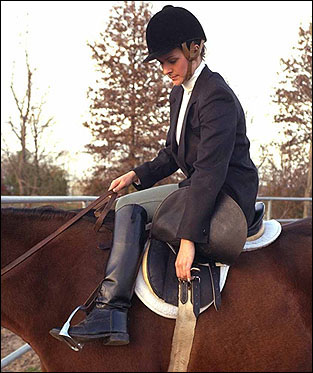
After you have ridden for a few minutes, check the girth again. This may seem like needless repetition, but it is necessary with most horses. Check without dismounting. Take the reins in your right hand and with your foot still in the stirrup, swing your left leg up and onto the horse's shoulder. Reach down with your left hand, lift the saddle flap and tighten the billet straps as needed (Figure 7).
If your horse desires to run faster than you wish to go, direct it in progressively smaller circles until you gain complete control. If your horse was given preliminary exercise before riding, this probably will not happen, but some horses are hard-mouthed or may be frightened.
Maintaining control also means holding the horse's attention. Do not let your horse eat while you are riding. While it is eating, it is not paying attention to you. If you let it eat, it will not respect you and may become unwilling to obey other commands.
Always watch ahead for things that may frighten your mount. You should never be simply a passenger; be an active participant, even on a quiet, well-trained horse.
Some horses are easily frightened and need constant reassurance from their riders. Such horses need to be exposed to a wide variety of potentially frightening situations while they are kept under control. The rider should actually seek out such situations and build them into a training program. It builds the horse's confidence and makes it safer to ride.
Riding in groups
Riding in groups usually is safer than riding alone, but group riding also has unique hazards. When starting off, everyone should wait until all are mounted before beginning to move away. Horses instinctively want to be in groups and the ones left behind will want to hurry to catch up. This makes mounting rather hazardous.
Allow at least one horse's length between your horse and the one ahead of you. This will eliminate danger from kicks or bites. Make sure the rider behind you stays well back from your horse's rear. Traditionally, a red ribbon in the tail of a horse denotes a known kicker. However, most horses will kick if they feel threatened by the horse behind them.
Riding on roads or in pastures
When riding along roads, the group should try to minimize hazards to themselves and to traffic. Crossing roads can be especially dangerous. All horses should cross simultaneously. This is done by riding single file, with the entire group turning onto the road at once. This type of crossing requires a long, straight stretch where oncoming motorists will be able to see the riders and slow down.
If you must ride on a hard surfaced road or a very narrow road shoulder, do not proceed faster than a trot. Your horse will be under more control and will be in much less danger of slipping. If such riding is routine, you may wish to purchase special shoes or have regular shoes treated to increase their grip. You also may wish to have your farrier put pads on your horse's feet, especially if there is large, sharp gravel.
The law in most states specifies that horse traffic must move in the same direction as vehicular traffic. Obviously, there will be times when this is impossible, but you must pay close attention to all legal aspects of using a horse on public thoroughfares. Make every effort to avoid potentially hazardous situations.
Riding in fields and pastures also can be hazardous. Avoid soft, deep footing that can rip shoes off and pull tendons. Don't ride if loose horses are present. They may run at the ridden horse and kick, bite or tease. If you must ride through loose horses, keep your speed to a minimum and don't try to outrun them.
If you have to catch a horse that has gotten away from its rider or catch your own horse that has broken loose from you, don't chase after the horse. Chasing only makes loose horses run faster. Talk soothingly and walk toward the horse. The loose horse also may be lured in with another horse.
Emergency dismounting
Safe equitation includes learning to make emergency dismounts. This requires a great deal of practice and should begin in a riding ring at the walk, then at the trot and eventually at the canter. Use a quiet, well-trained horse for practice. As you ride, kick both feet out of the stirrups and drop your hands to the withers, but maintain contact with the reins.
Aided by the natural rhythm of the horse's movement, push away with your hands, swinging your right leg back over the croup and bringing both legs forward quickly and as close together as possible. Maintain your balance by holding onto the front of the saddle or the horse's mane. Practice dismounting this way on both sides of the horse.
When going up a steep incline, make your horse as comfortable and balanced as possible by leaning forward slightly and giving the horse the free hand. By placing yourself over the horse's center of gravity, you will assist him in climbing.
Going downhill requires that the horse's hindquarters be free. To accomplish this, lean slightly forward. Keep your hands low so that the horse may use his head and neck for balancing. The horse must keep its hindquarters under it and its head and neck down, especially going down a steep slope.
When crossing water, take the shallowest, calmest spot and head diagonally into the current. Don't look down. The motion of the water may cause you to lose your balance and fall from your horse. Kick your feet from the stirrups in case the horse should fall.
Jumping safely
Make jumping as safe as possible by never attempting any fences unless you are riding a carefully trained horse. This is especially important if you ride alone.
Jumping is safer when riding in a group. Proceed in single file, leaving enough space so that a rider has cleared the jump successfully before the following rider starts. Before proceeding, make certain that the rider ahead of you is not having difficulties.
Never attempt to jump over wire. Wire is extremely difficult for horses to see until the last instant before take-off If you must jump wire make a visible barrier by piling brush against it or laying a coat over it. Even under these conditions, jumping wire is very hazardous.
Cool the horse after riding
At the end of each ride, cool your horse down carefully. This will prevent founder or other serious problems Walk the horse slowly until its respiration has returned to normal and the coat is dry. Don't feed grain for at least an hour after hard work. You may give it a little water, a few swallows at a time, while it is cooling down.
Leading with double reins
To lead a horse with double reins, leave the curb rein on the neck. Bring the snaffle rein forward over the head and lead with it. Bring both reins forward and hold them if you wish, but this is awkward. If you lead with both reins, don't put pressure on the curb rein.
Lead a horse with the curb reins only if you know the horse is familiar with this procedure. Be careful not to jerk its mouth or twist the bit.
When you leave reins on a horse's neck, prevent them from looping down and being stepped on. Do this by tucking the rein under one of the run-up stirrups. If the rein is long enough, tuck it under both stirrups.